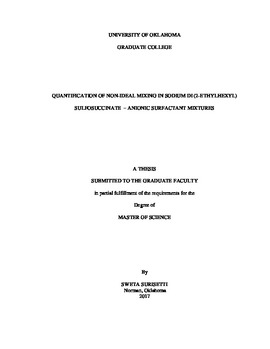| dc.contributor.advisor | Harwell, Jeffrey | |
| dc.contributor.author | Surisetti, Sweta | |
| dc.date.accessioned | 2017-05-10T15:16:14Z | |
| dc.date.available | 2017-05-10T15:16:14Z | |
| dc.date.issued | 2017-05 | |
| dc.identifier.uri | https://hdl.handle.net/11244/50749 | |
| dc.description.abstract | HLD equation was first introduced by Salager [1], however for predicting the HLD parameters from known parameters of a surfactant in a binary anionic-anionic mixture, Acosta [8] suggested linear mixing rules which can be applied to the HLD equation. The linear mixing rules have been shown to work for various anionic-anionic surfactants. However, while performing a phase behavior with Sodium di(2-ethylhexyl) sulfosuccinate or commercially known as AEROSOL-OT or AOT, a deviation from ideal mixing has been observed. In order to quantify this non-ideality, a microemulsion phase study (salinity scan) was performed on AOT. AOT cannot form a middle phase microemulsion by itself, hence AOT was mixed with a reference surfactant to obtain Winsor III microemulsions. The reference surfactants used to perform the salinity scan were a twin-tailed surfactant and two linear chained alkyl sulfates. The twin-tailed reference surfactant used was Sodium dihexyl sulfosuccinate or commercially also known as AMA and the linear chained alkyl sulfates were ALFOTERRA 8-41S and ISALCHEM 123-2. The salinity scan was performed at 25°C at different mole fractions of AOT i.e. 0.1, 0.3, 0.5 and 0.7 in different oils namely pentane, hexane, heptane, octane and decane. After performing the salinity scan and determining the KAOT and CcAOT using the linear mixing rules, it was observed that the linear mixing rules fail to satisfy the HLD equation in the case of an AOT mixture. Deviations from ideal-mixing were quantified in terms of Gibbs free energy and negative normalized Gibbs free energy values were obtained for all the three systems indicating the existence of strong driving forces in AOT-anionic mixtures to make microemulsions at room temperature. The largest deviations were observed in the AOT/AMA mixture probably because of low packing. It was also observed that a mixture of high Cc and low Cc valued surfactants irrespective of their structural differences showed to have much lower deviations from non-ideal mixing as compared to two similarly structured surfactants like AOT/AMA. | en_US |
| dc.language | en_US | en_US |
| dc.subject | Surfactant Non-ideal Mixing | en_US |
| dc.subject | SODIUM DI(2-ETHYLHEXYL) SULFOSUCCINATE | en_US |
| dc.subject | Surfactant mixtures | en_US |
| dc.title | QUANTIFICATION OF NON-IDEAL MIXING IN SODIUM DI (2-ETHYLHEXYL) SULFOSUCCINATE – ANIONIC SURFACTANT MIXTURES | en_US |
| dc.contributor.committeeMember | Lobban, Lance | |
| dc.contributor.committeeMember | Shiau, Benjamin | |
| dc.date.manuscript | 2017-03 | |
| dc.thesis.degree | Master of Science | en_US |
| ou.group | College of Engineering::School of Chemical, Biological and Materials Engineering | en_US |
| shareok.nativefileaccess | restricted | en_US |
